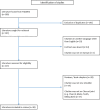Charcot Neuroarthropathy of the Shoulder Caused by Cervical Spondylotic Myelopathy: A Case Report and Literature Review
- PMID: 39156265
- PMCID: PMC11329796
- DOI: 10.7759/cureus.64776
Charcot Neuroarthropathy of the Shoulder Caused by Cervical Spondylotic Myelopathy: A Case Report and Literature Review
Abstract
Charcot neuroarthropathy (CN) is a chronic degenerative disorder of bones and joints, mostly associated with diabetes mellitus and human immunodeficiency virus. CN of the upper limb is rare, with only 58 case reports identified on PubMed with the majority of cases being closely associated with syringomyelia. Very rarely, cervical spondylotic myelopathy (CSM) is associated with CN of the upper limb; with very few literature reporting this association. This case report presents a rare case of Charcot arthropathy of the shoulder caused by CSM. A 57-year-old female presented to the emergency department following trauma to the right shoulder. On clinical examination, there was evidence of tenderness, extensive swelling, and bruising with a lack of range of motion along with numbness in the right arm and legs. Through radiographic and laboratory investigations, a diagnosis of CN secondary to CSM was made. A reverse total shoulder arthroplasty was performed however, this was complicated at two weeks with an atraumatic glenoid fracture and dislocation. First-stage revision surgery was then performed to allow fracture healing pending second-stage revision surgery. This report provides insight into the very rare possibility of the association of CN of the shoulder with CSM. A review of the literature suggests reverse shoulder arthroplasty is the gold standard for cases of severe bone and soft tissue damage. When undergoing investigations for Charcot neuroarthropathy, physicians must undertake a full detailed history along with a detailed neurological examination and imaging of the cervical spine to not miss the association with CSM.
Keywords: cervical spondylotic myelopathy (csm); charcot neuroarthopathy; charcot's joint; reverse shoulder arthoplasty; syringomyelia.
Copyright © 2024, Park et al.
Conflict of interest statement
Human subjects: Consent was obtained or waived by all participants in this study. Conflicts of interest: In compliance with the ICMJE uniform disclosure form, all authors declare the following: Payment/services info: All authors have declared that no financial support was received from any organization for the submitted work. Financial relationships: All authors have declared that they have no financial relationships at present or within the previous three years with any organizations that might have an interest in the submitted work. Other relationships: All authors have declared that there are no other relationships or activities that could appear to have influenced the submitted work.
Figures






Similar articles
-
Cervical spondylotic myelopathy with syringomyelia presenting as hip Charcot neuroarthropathy: A case report and review of literature.World J Clin Cases. 2022 Jan 21;10(3):1077-1085. doi: 10.12998/wjcc.v10.i3.1077. World J Clin Cases. 2022. PMID: 35127922 Free PMC article.
-
Multi-joint Charcot arthropathy caused by cervical spondylotic myelopathy and adult degenerative scoliosis with syringomyelia: a case report.Br J Neurosurg. 2023 Dec;37(6):1843-1849. doi: 10.1080/02688697.2021.1940861. Epub 2021 Jun 29. Br J Neurosurg. 2023. PMID: 34184598
-
Charcot arthropathy of the wrist associated with cervical spondylotic myelopathy.Global Spine J. 2012 Dec;2(4):227-30. doi: 10.1055/s-0032-1315457. Epub 2012 Aug 24. Global Spine J. 2012. PMID: 24353972 Free PMC article.
-
Recent advances in the management of cervical spondylotic myelopathy: bibliometric analysis and surgical perspectives.J Neurosurg Spine. 2019 Sep 1;31(3):299-309. doi: 10.3171/2019.5.SPINE18769. Epub 2019 Sep 1. J Neurosurg Spine. 2019. PMID: 31473666
-
Shoulder arthropathy secondary to syringomyelia: systematic review.EFORT Open Rev. 2023 Jan 27;8(1):26-34. doi: 10.1530/EOR-22-0008. EFORT Open Rev. 2023. PMID: 36705617 Free PMC article. Review.
Cited by
-
Charcot arthropathy of the shoulder joint following Arnold-Chiari malformation: A case report.Int J Surg Case Rep. 2025 Sep;134:111741. doi: 10.1016/j.ijscr.2025.111741. Epub 2025 Jul 30. Int J Surg Case Rep. 2025. PMID: 40795722 Free PMC article.
References
-
- Neuropathic arthropathy: review of current knowledge. Alpert SW, Koval KJ, Zuckerman JD. Journal of the American Academy of Orthopaedic Surgeons. 2006;4:100–108. - PubMed
-
- Charcot shoulder and elbow: a review of the literature and update on treatment. Snoddy MC, Lee DH, Kuhn JE. J Shoulder Elbow Surg. 2017;26:544–552. - PubMed
-
- Multi-joint Charcot arthropathy caused by cervical spondylotic myelopathy and adult degenerative scoliosis with syringomyelia: a case report. Shi X, Li P, Wang L, Zhang J. Br J Neurosurg. 2023;37:1843–1849. - PubMed
Publication types
LinkOut - more resources
Full Text Sources
